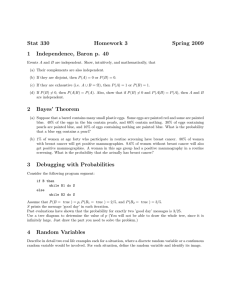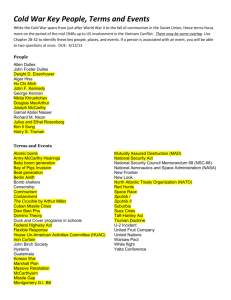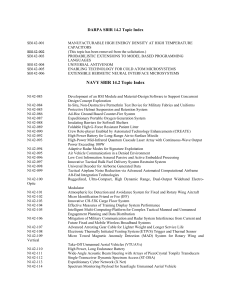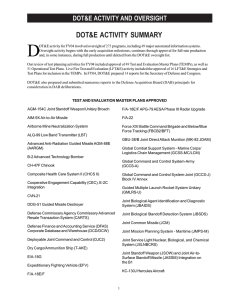T Line-of-Sight Anti-Tank Missile (LOSAT) ARMY PROGRAMS
advertisement
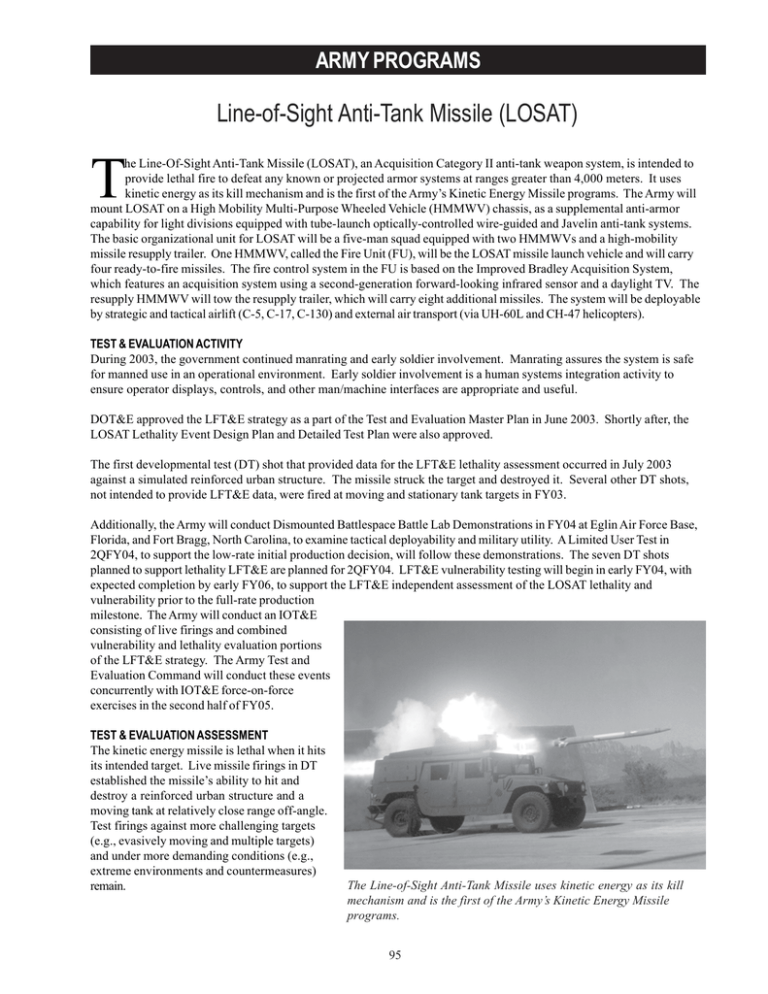
ARMY PROGRAMS Line-of-Sight Anti-Tank Missile (LOSAT) T he Line-Of-Sight Anti-Tank Missile (LOSAT), an Acquisition Category II anti-tank weapon system, is intended to provide lethal fire to defeat any known or projected armor systems at ranges greater than 4,000 meters. It uses kinetic energy as its kill mechanism and is the first of the Army’s Kinetic Energy Missile programs. The Army will mount LOSAT on a High Mobility Multi-Purpose Wheeled Vehicle (HMMWV) chassis, as a supplemental anti-armor capability for light divisions equipped with tube-launch optically-controlled wire-guided and Javelin anti-tank systems. The basic organizational unit for LOSAT will be a five-man squad equipped with two HMMWVs and a high-mobility missile resupply trailer. One HMMWV, called the Fire Unit (FU), will be the LOSAT missile launch vehicle and will carry four ready-to-fire missiles. The fire control system in the FU is based on the Improved Bradley Acquisition System, which features an acquisition system using a second-generation forward-looking infrared sensor and a daylight TV. The resupply HMMWV will tow the resupply trailer, which will carry eight additional missiles. The system will be deployable by strategic and tactical airlift (C-5, C-17, C-130) and external air transport (via UH-60L and CH-47 helicopters). TEST & EVALUATION ACTIVITY During 2003, the government continued manrating and early soldier involvement. Manrating assures the system is safe for manned use in an operational environment. Early soldier involvement is a human systems integration activity to ensure operator displays, controls, and other man/machine interfaces are appropriate and useful. DOT&E approved the LFT&E strategy as a part of the Test and Evaluation Master Plan in June 2003. Shortly after, the LOSAT Lethality Event Design Plan and Detailed Test Plan were also approved. The first developmental test (DT) shot that provided data for the LFT&E lethality assessment occurred in July 2003 against a simulated reinforced urban structure. The missile struck the target and destroyed it. Several other DT shots, not intended to provide LFT&E data, were fired at moving and stationary tank targets in FY03. Additionally, the Army will conduct Dismounted Battlespace Battle Lab Demonstrations in FY04 at Eglin Air Force Base, Florida, and Fort Bragg, North Carolina, to examine tactical deployability and military utility. A Limited User Test in 2QFY04, to support the low-rate initial production decision, will follow these demonstrations. The seven DT shots planned to support lethality LFT&E are planned for 2QFY04. LFT&E vulnerability testing will begin in early FY04, with expected completion by early FY06, to support the LFT&E independent assessment of the LOSAT lethality and vulnerability prior to the full-rate production milestone. The Army will conduct an IOT&E consisting of live firings and combined vulnerability and lethality evaluation portions of the LFT&E strategy. The Army Test and Evaluation Command will conduct these events concurrently with IOT&E force-on-force exercises in the second half of FY05. TEST & EVALUATION ASSESSMENT The kinetic energy missile is lethal when it hits its intended target. Live missile firings in DT established the missile’s ability to hit and destroy a reinforced urban structure and a moving tank at relatively close range off-angle. Test firings against more challenging targets (e.g., evasively moving and multiple targets) and under more demanding conditions (e.g., extreme environments and countermeasures) remain. The Line-of-Sight Anti-Tank Missile uses kinetic energy as its kill mechanism and is the first of the Army’s Kinetic Energy Missile programs. 95 ARMY PROGRAMS Recently, the Army delayed the missile flight program so the Program Manager can investigate cracks that appeared in a heat-conditioned missile motor. The heat cracks are a safety concern and the delay in the firing program will impact the safety release for man-in-the-cab missile firings. The survivability of the overall system is an issue. The Program Manager chose to trade some ballistic protection for enhanced deployability (to ensure that the LOSAT system remains sling-loadable from a UH-60L helicopter). The LFT&E program will assess the degree to which the LOSAT system, including the missile, both HMMWV vehicles, and the loaded trailer, is vulnerable to the expected threats. This program describes critical vulnerability and lethality issues and the scope of testing needed to address them, including the need for more than one FU for full-up, system-level LFT&E to support the planned full-rate production decision. 96

